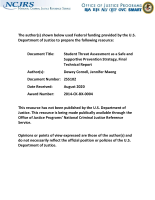Juvenile justice
Criminal Careers and Crime Control: A Matched-Sample Longitudinal Research Design, Phase I - A User's Guide to the Machine-Readable Files and Documentation and Codebook
Student Threat Assessment as a Safe and Supportive Prevention Strategy, Final Technical Report
Countering Technology-Facilitated Abuse: Criminal Justice Strategies for Combating Nonconsensual Pornography, Sextortion, Doxing, and Swatting
Summary Overview Report: Student Threat Assessment as a Safe and Supportive Prevention Strategy
Final Summary Overview: Understanding the Impact of School Safety on the High School Transition Experience: From Etiology to Prevention
At-Risk Youth in Schools: A Wraparound Delinquency Prevention Program Produces Disappointing Results
A Comprehensive School Safety Framework: Report to the Committees on Appropriations
Teen Cyberbullying Content Assessed in the Context of Social Networks
Biomechanical Investigation of the Effect of Bone Disorders on Pediatric Femur Fracture Potential
Juveniles in Residential Placement, 2017
Implementing a School Tip Line? New Research Provides a Blueprint
Notes From the Field: Reducing the Need for Victim Testimony in Human Trafficking Cases
Video: Do Students and Staff Know What To Do During a Violent-Emergency?
Video: Impact on School Safety of Collaboration Between Law Enforcement & Rural Schools
Video: How Prepared Are Schools?
Impact on School Safety of Collaboration Between Law Enforcement & Rural Schools
Dr. Scalora discusses his NIJ-funded research that looks at how police engagement and collaboration with rural school districts impact emergency operation planning and other aspects of school violence prevention.
See the YouTube Terms of Service and Google Privacy Policy
How Prepared Are Schools?
How prepared are schools for emergencies? Dr. Silva discusses her NIJ-funded research that looked at whether or not federal guidelines were reaching schools; the levels of emergency preparedness at the state, district, and school level; what we can learn from well-prepared schools, both best practices and challenges.
See the YouTube Terms of Service and Google Privacy Policy



